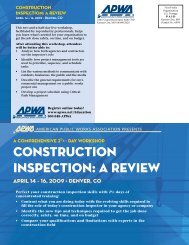Privatization - American Public Works Association
Privatization - American Public Works Association
Privatization - American Public Works Association
- No tags were found...
Create successful ePaper yourself
Turn your PDF publications into a flip-book with our unique Google optimized e-Paper software.
What is <strong>Privatization</strong>?
<strong>Privatization</strong> DefinedThe shifting of the productionof a good or the provision of aservice from government tothe private sector.
Dragged Kicking & Screaming!
First Attempt – Failure!
Crack FillingPour PotWand
The numbersPrivate contractors$ 0.85 - $1.25/ PoundCity of Wauwatosa *$ 2.95/pound* Estimated by Dr. Bill Tarman-Ramcheck 4/28/03
“For the purpose of subcontracting the Citychooses to implement, the City may transferemployees involuntarily (a) to another jobassignment in their classification or (b) toanother classification assignment which willnot cause a constructive discharge (i.e. a jobwhich the employee cannot perform) orreasonable change in working conditions frothat employee. The involuntarily transferredemployee will not lose pay or 40 hours ofregular work per week.”
Street Lighting• Privatized 1990• Multiple bidders• Outdoor Lighting• Retained contract until1998• Contract Bid 1998• Two bidders• Pieper Electric• Contract until 2000• Extended until 2001• Extra costs & control2001 Budget presentationrecommended returningstreet lighting in-houseStill had vehicles &equipment• First full year of operatingended June 2003• Saved over $25,000• Continue to monitorexpenditures
Construction Inspection• Owners representative on the job• Answers questions from residents• Makes sure contractor is performing properinstallations• Makes in-field decisions
Construction Inspection• 2002 added one construction inspector to staff• Picked up 750 hours plus of work time notreceived from Contract inspectors-annually• Used time to get as-builds unto plans• More satisfied with level of inspection
Street Sweeping• Privatized in 1984 as part of an omnibus SolidWaste agreement• 2003 Specifications for Street Sweeping were sentout separately• Two proposals were received from private contractsweeper companies in addition to City ofMilwaukee
Street Sweeping 2003• Company A(Wauwatosa handlessweepings)• Company B(Wauwatosa handlessweepings)City of MilwaukeeHauling & Disposal ofsweepings includedDid not include cost ofdisposal of sweepings• $68, 424*• $ 69, 588*• $ 69, 470.09• Estimated cost ofhauling & disposal$11,900
2004 Street Sweeping• City of Milwaukee• City of Wauwatosa7% plus increasePrice just under $75,000Multipurpose piece ofequipmentControl of OperationCosts with Fringes& increased sweeping$67,388.26
Other areas of <strong>Privatization</strong>• Pavement Marking• Yard Waste Collection & Recycling• Construction Inspection – <strong>Public</strong> & Private• All Street & Sidewalk Construction• Dutch Elm removals - <strong>Public</strong> & Private• Boulevard maintenance – grass cutting• Boulevard maintenance – Flowers
A Hybrid Approach
Single Stream Collection Cartsdelivered in November of 2007
February 7, 2008
April 15, 2009
WHAT LIES AHEAD?• Solid Waste Collection• Traffic Sign Production &Installation• Utility Cut Restoration• Fleet Maintenance• Engineering –Designs &Specifications• Survey work• Hotline Utilities• Snow Plowing
What’s my Best Advice?
10/1/2009An Historical Look at Private Firmsand <strong>Public</strong> ServicesCharles David Jacobson, Ph.D.<strong>Public</strong> Policy and Historical ConsultantsThe Surprisingly InterestingBaltimore <strong>Public</strong> <strong>Works</strong> MuseumTaking the Long ViewHistory of roles played by private firms and government agencies infurnishing public services & building public works systemsover the last 150 years is also worthy of examination.1. It’s very interesting.2. Enriches the universe of case studies.3. By examining and comparing the workings of arrangementsover long periods of time, otherwise invisible patterns andcausal relationships are revealed.1
10/1/2009Three Different <strong>Public</strong>Services– Solid Waste Collection & Disposal– Water Supply & Distribution– Electricity Supply and DistributionSolid Waste Collection &Disposal• During the early & mid-19th century, citizensoften responsible for disposing of own wastes(e.g. out the window method.)• Prompted by sanitary and public healthconcerns, local governments in many largercities assumed responsibility for solid wastecollection and disposal during the latenineteenth century.Early Solid Waste Collection &Disposal ArrangementsInitially, most local governments enteredinto contracts with private firms tofurnish service.Contracts sometimes put out forcompetitive bid.Contracts typically short term (1 to 5years)2
10/1/2009Advantages of PrivateProvision– Consistent with free enterprise ideology.– Did not require large scale hiring of publicemployees or expansion of bureaucracy.– Competition between firms for contractsappeared to afford a means of ensuringgood quality service at reasonable cost.Problems of Private Provision• Private firms reluctant to build expensive fixedfacilities (e.g. incinerators) without security oflong term contract. But long term contractmeans reduced market discipline/competitionover time.• Allegations of skimping on service quality toboost profits.• Allegations of corruption and favoritism incontract awards or oversight of service.• Allegations of undue contractor influence inpolitics.A Complaint ofCorruption inNew York City.New York Times, March 6, 19093
10/1/2009Arguments for GovernmentOwnership• Means to reduce municipal corruption and undueprivate influence over government.• Means to obtain improved disposal facilities (e.g.incinerators)• Means to ensure better quality collection service andpractices (e.g covered carts, more thoroughcollection).A Call forGovernmentOwnership• Los Angeles Times,February 18, 1905A Turn to GovernmentOwnership• During the first & second decades of the 20thcentury, municipal governments increasinglychose to furnish solid waste collectionthemselves.• Within government, responsibility foroversight of service increasingly passed fromphysicians & public health commissions todepartments of public works & professionalengineers & managers.4
10/1/2009A Partial Trend Reversal• Since 1970, something of resurgence inprivate provision, particularly in smallercommunities.– Ideology– Desires to cut costs & to avoid bargaining (orstrengthen bargaining position with) unionizedworkers.– Rise of professionally managed large solid wastemanagement firms.– Difficulty in siting landfills & disposal facilities andresulting export of waste to centralized recyclingfacilities and/or distant & often private landfills.Water Supply & Distribution• As in solid wastes, municipal governments during the19th century typically turned to private firms to buildwater supply & distribution systems.• As in solid wastes, private firms at times competedfor contracts or franchises.• Unlike solid wastes, long term contracting orfranchises prevailed.• Once long term contract or franchise in place, thereno further competition. Performance depended onprivate firm’s decision-making and continuedenforceability & suitability of contract terms.What Happened?• Viable long term relationships between local governments &water works firms in some smaller communities with littlepopulation growth.• Relationships between local governments & private water worksfirms often became dysfunctional in rapidly growing g major cities.– Problems in enforcing contract terms.– Contract terms themselves became obsolete as conditionschanged and system expansion needed.– Difficulties in measuring “output” and monitoring quality ofsuch services as water for fire protection contributed toproblems.– In fire protection, for example, paying firms a given fee perfire hydrant did not meaningfully relate to such importantfeatures of service provision as the size of water mainsserving the hydrant, water pressures, etc.5
10/1/2009Seattle After the Fire of 1889Electric Utilities• Initial electric utility development in urban centers in the United States begancirca the 1880s.• Similarities to Water <strong>Works</strong>– Electric utilities consist of fixed & expensive facilities serving both privateconsumers & specifically public needs.– Private firms built and operated the first systems in most <strong>American</strong>communities.– As in both solid wastes & water works, relationships between private firmsand government agencies sometimes conflictual and/or a source ofcontroversy.• Allegations of corruption in contract awards or administration.• Allegations of undue private influence over government.• Allegations of overly high prices/bid rigging for public services such as streetlighting.• Allegations of overly high prices for public and/or private consumer services.Electric Utilities• Differences between Electric Utilities and Water <strong>Works</strong>– Arranging for provision of high quality services did not prove nearly as difficult inelectric utilities as in water works.– Output of public services such as electric street lighting could be easily measured andmonitored with the naked eye.– Electric utility firms faced market forces to a greater degree than did their water workscounterparts.Private ownership of electric utilities survived in most <strong>American</strong> communities.Exceptions in cases in which public ownership seen as necessary to realizepublic ends.– During the early 20th century, for example, municipal governments in Seattle andLos Angeles built electric utility systems as means to obtain inexpensive hydro-electricpower for economic development.6
10/1/2009Factors Historically ShapingPerformance of Private Firms• Capabilities of firms themselves.• Extent to which firms furnish similar services toprivate or other consumers.• Extent of competition in markets served.• Ease or difficulty in measuring output.• Ease or difficulty in monitoring quality of output.• Extent to which expensive fixed facilities needed forservice.Conclusion• Profit-motivated private firms can playvaluable roles in providing public services.But:– Because of firms’ profit-orientation and fiduciaryresponsibilities to share-holders, attention to firm capabilities,market forces, and design of contractual arrangements isneeded.– History teaches that over long periods, surprises will happen,the future will be different than the present in unpredictableways.– Caution is indicated in entering into long term arrangementsinvolving private ownership of expensive fixed facilities.– Private ownership of such facilities can greatly complicatetask of adapting to change, shifting policy in new directions.And a final note7
















